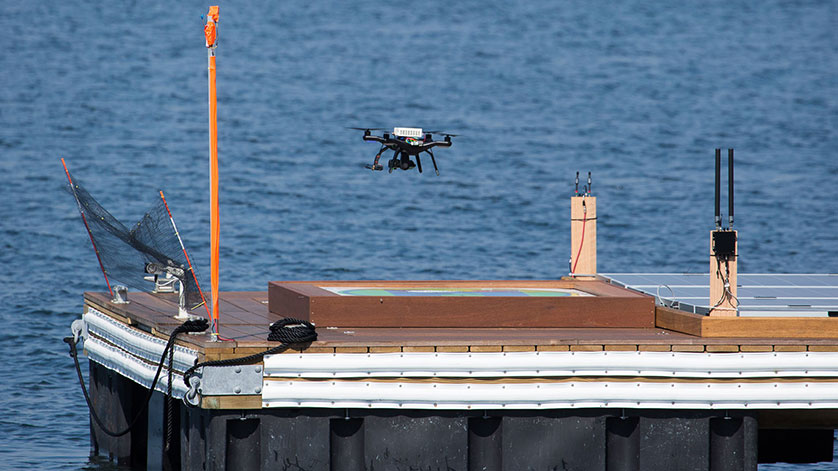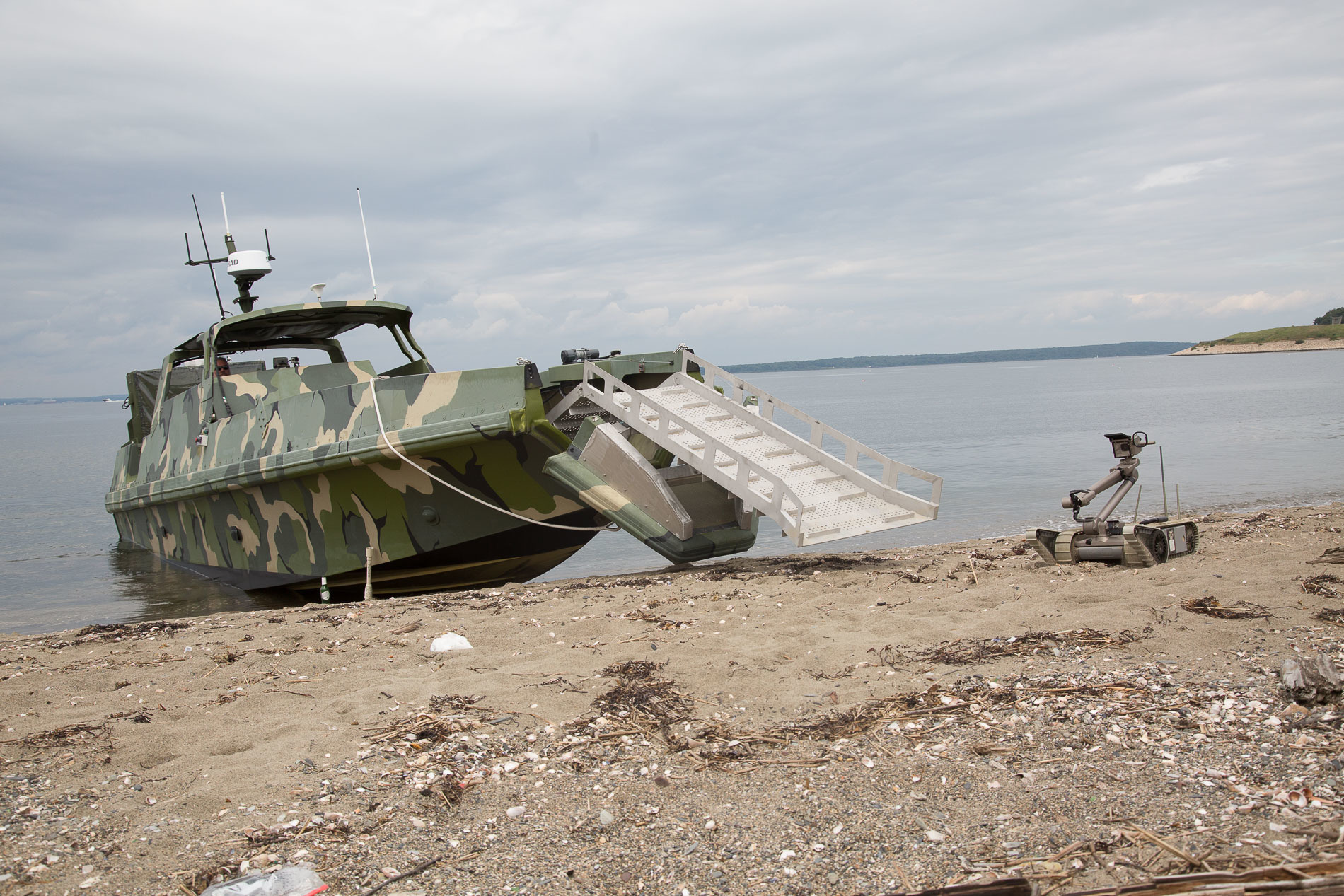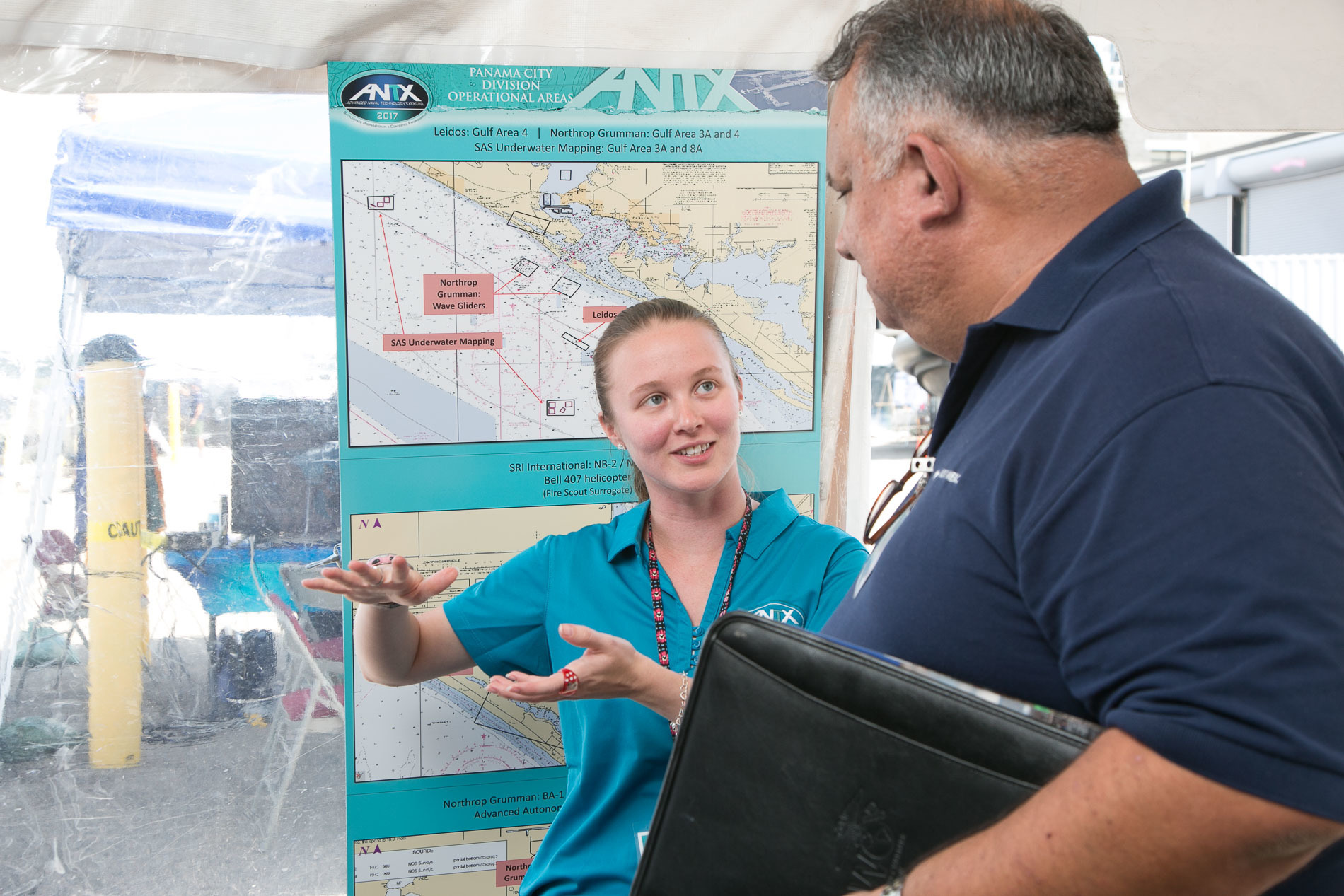ANTX Provided Venue for Rapid Prototyping, Fleet Engagement

From Aug. 15-16, the Advanced Naval Technology Exercise (ANTX) 2017 Battlespace Preparation in a Contested Environment (BPCE) took place at both the Naval Undersea Warfare Center Division Newport and the Naval Surface Warfare Center Panama City Division, partnering with fleet operators from Submarine Development Squadron Five from Keyport, Washington, and the Explosive Ordnance Disposal Mobile Unit One in Panama City, Fla.
The multi-site event featured live exercises of tasks above and below the water including bordering shorelines and welcomed more than 700 attendees who observed 50 unmanned systems in action — 11 unmanned aerial vehicles (UAVs), 9 unmanned surface vehicles (USVs), 28 unmanned underwater vehicles (UUVs), and two unmanned ground vehicles (UGVs). NUWC Newport exercises focused on Intelligence, Surveillance, and Reconnaissance (ISR), while NSWC Panama City exercises focused on Mine Warfare (MIW) and Mine Countermeasures (MCM).
ANTX BPCE met its critical goal of the undetected collection, fusion, and transmission of data, exercising technology enablers that facilitate autonomous operations, and the successful coordination among autonomous platforms and their operators.
The event also provided an opportunity for pier-side collaboration among technology developers from industry, academia, and warfare centers, and Navy operators and program offices. This collaboration created the high-velocity learning environment critical to supporting rapid prototyping of innovative, emerging technologies. The target audience for ANTX is Fleet operators who will one day use these systems, Navy decision-makers who direct acquisition funding, as well as the Navy’s industry and academic partners interested in forming the future partnerships that will speed the research, development, test, and evaluation timeline.
"I look to the scientists and engineers, alongside the uniformed warfighters, to combine their expertise and insight in technology and operating concepts to help us continue to be able to fight and win going forward," said Adm. Phil Davidson, Commander, U.S. Fleet Forces during his kick-off remarks via video teleconference.
Maj. Gen. David Coffman, OPNAV N95 from the Pentagon, served as the keynote speaker and told reporters that NAVSEA Warfare Centers are vital to the transition of technical capabilities from the labs to the fleet. "I think the really brilliant people that we have working here at the center and all of our Warfare Centers are key to that," said Coffman.
Rapid prototyping in action
Rapid prototyping, or accelerating the process that gets new technology into the hands of the warfighters, is a big component of ANTX and was on full display as research engineers and chemists from NUWC Newport’s Energy and Propulsion Branch partnered with Riptide Autonomous Solutions to successfully test a proton exchange membrane (PEM) fuel cell-powered micro UUV. Their collaboration began at ANTX 2016 when NUWC researchers showcased their work in the areas of lithium batteries, solid oxide fuel cells, and metal hydrides. When not manning the booth, research engineer and Navy diver Christian Schumacher worked with NUWC Newport’s Engineering and Diving Support Unit to support Massachusetts-based Riptide Autonomous Solutions, who was testing their micro-UUV.
“I brought the Riptide team from the dive boat to our Power and Energy tent and all of us quickly coalesced on one of our display fuel cells that would fit in their vehicle,” said Schumacher. “In fact, Riptide brought an empty hull section over to our tent, and we dry fit the fuel cell real time.” As a result of the year-long collaboration, ANTX 2017 featured the integration of Riptide’s commercially available vehicle and NUWC Newport’s PEM fuel cell. The team had previously estimated they were about five years away from testing a PEM fuel cell-powered vehicle in the water but the meeting at ANTX 2016 allowed for rapid prototyping to occur.
“If we didn’t meet up with Riptide at ANTX, we wouldn’t be demonstrating this year. We wouldn’t have used a micro UUV,” said Dr. Lou Carreiro of NUWC Newport. “We had two parties interested in working together to advance the technology and we’re doing it now.”
“The point here is, in a low-risk environment, to check out the technology that’s here and how can we get it out to the war fighter,” said NSWC Panama City Commanding Officer Capt. Aaron Peters. “What’s going to be that next big thing, that game changer that we get out to the war fighter? Well, you’ve got to do events like this. When you do events like this, you can see whether or not that will work. We want to expand the advantage and give us the war-fighting edge.”
 Led by the Naval Surface Warfare Center Indian Head Explosive Ordnance Disposal Technology Division, this simulated mission involves deploying Explosive Ordnance Disposal Unmanned Ground Vehicle (UGV) assets from a converted autonomous Advanced Composite Riverine Craft (ACRC) during the 2017 Advanced Naval Technology Exercise, Narragansett Bay Test Facility, Newport, R.I., Aug. 15..The autonomous ACRC delivers the UGVs to the beach to conduct threat detection and neutralization operations, through a combination of semi-autonomous and tele-operative control. Photo by David Stoehr.
Led by the Naval Surface Warfare Center Indian Head Explosive Ordnance Disposal Technology Division, this simulated mission involves deploying Explosive Ordnance Disposal Unmanned Ground Vehicle (UGV) assets from a converted autonomous Advanced Composite Riverine Craft (ACRC) during the 2017 Advanced Naval Technology Exercise, Narragansett Bay Test Facility, Newport, R.I., Aug. 15..The autonomous ACRC delivers the UGVs to the beach to conduct threat detection and neutralization operations, through a combination of semi-autonomous and tele-operative control. Photo by David Stoehr.
ANTX technologies
Adaptive Methods used a UUV with a tethered buoy outfitted with a large field of view video and light/radar, or LIDAR, rangefinder to autonomously locate a target of interest from an on-station position. (Panama City)
Aviation System Engineering Company Inc. deployed from a fixed-wing aircraft an A-sized sonotube with a Lockblade Quadcopter that descends, automatically unfolds and stabilizes, and autonomously conducts an aerial magnetic anomaly detection survey. (Newport)
Boeing demonstrated the ability to utilize a Sensor Hosting Autonomous Remote Craft USV to trail a towbody that deploys an array of long baseline precision navigation transponders to establish an undersea navigation network for UUVs, similar to GPS for air/ground vehicles. (Newport)
DeTect Intelligent Sensors provided persistent situational awareness of surface vessels and unmanned aerial system platforms operating in the St. Andrew Bay operational area. (Panama City)
Domo Tactical Communications employed its Maritime Mesh to connect ANTX maritime assets together in a seamless network with the use of a high-speed, high-capacity digital communication channel. (Newport)
Engineering Professional Services demonstrated its OCTOPOD underwater crawler as it transmitted acoustic signals to a buoy from multiple locations demonstrating communication from different seabed terrains, depths, and ranges. (Panama City)
General Dynamics Mission Systems ran two exercises that demonstrated system of systems battlespace preparation; simulated submarine launch of UUVs and UAVs; UUV insertion of cross-domain autonomous systems; rapid data collection with multi-system cooperative operations; advanced autonomy; and cross-domain command, control and communications using undersea distributed networks. (Newport)
Hydroid Inc. and L3 Technologies Mission Integration collaborated to integrate the L3 Rio Signals Intelligence system into the Hydroid Remus 600 UUV. The exercise included surfacing to intercept, monitor, and record a signals intelligence target, followed by submerging to launch a Sparton Hammerhead canister containing an AeroVironment Blackwing UAV. (Newport)
iXblue exercised its Global Acoustic Positioning System (GAPS), a man-portable ultra-short baseline tracking system to enable the Teledyne Gavia autonomous underwater vehicle (AUV) to perform a high-accuracy MCM survey by providing its standard Inertial Navigation System/Doppler Velocity Log navigation suite position updates via acomms. GAPS allows for quick and easy deployment from vessel of opportunity, providing the Navy with operational versatility for precision tracking of UUV swarms. (Newport)
L-3 exercised its state-of-the-art, 360-degree high-definition and data acquisition system sensors to collect panoramic imagery for above-water situational awareness and collect data on unmanned aerial vehicles. (Newport)
Leidos demonstrated autonomous bathymetric survey capability using the Sea hunter surrogate test vessel, R/V Pathfinder, equipped with a high-resolution bathymetry collections suite to collect intelligence and preparation of the environment, or IPOE, specific data. (Panama City)
Northrop Grumman demonstrated collaborative autonomous systems — 6 UUVs, 2 USVs, and 1 UAV surrogate — that provided access, surveillance, and attack of seabed infrastructure. (Panama City)
NUWC Newport’s Undersea Warfare Combat Systems Department partnered with the Office of Naval Research, AeroVironment, Sparton, General Dynamics Mission Systems, Ocean Server Technology, and Hydroid for an exercise that applied multi-domain unmanned systems platforms and sensors to rapid environmental characterization. (Newport)
NSWC Indian Head Explosive Ordnance Disposal Technology Division and NSWC Carderock Division partnered to deploy Explosive Ordnance Disposal UGV assets from an Advanced Concept Riverine Craft (ACRC). The autonomous ACRC delivered a UGV to the beach to conduct threat detection and neutralization operations. (Newport)
NSWC Panama City had six different demonstrations including “Single Sortie Detect to Engage Unmanned Surface Vessel-based Mine Neutralization,” which deployed a tetherless mine neutralization UUV surrogate deployed from an 11-meter rigid hull inflatable boat.
 An employee from Naval Undersea Warfare Center Division Newport talks about events planned during the 2017 Advanced Naval Technology Exercise held at the Narragansett Bay Test Facility on Aug. 15 and 16. ANTX is an annual event designed to test new technology with academic, industry and Navy participants. The theme of this year's ANTX was Battlespace Preparation in a Contested Environment. Photo by Richard Allen.
An employee from Naval Undersea Warfare Center Division Newport talks about events planned during the 2017 Advanced Naval Technology Exercise held at the Narragansett Bay Test Facility on Aug. 15 and 16. ANTX is an annual event designed to test new technology with academic, industry and Navy participants. The theme of this year's ANTX was Battlespace Preparation in a Contested Environment. Photo by Richard Allen.
As part of the Smart Mining Initiative, a rapid prototyping team demonstrated a suite of modern sensors, UAVs, UUVs, and communications equipment that provided command and control and data exfiltration to the ANTX Command Center.
“Multimode SAS System for Underwater Mapping and Mine Countermeasures” used the latest generation small synthetic aperture minehunter/REMUS AUV to demonstrate the effectiveness and flexibility of wide-beam, multi-frequency, multi-mode imaging synthetic aperture sonar.
“Buried Object Localization Using a Supervised Autonomous Platform” demonstrated autonomous behaviors on the Dive Buddy Remotely Operated Vehicle using a forward-looking sonar for obstacle avoidance, situational awareness, and to evaluate any surface expression of the buried targets.
“Advanced Autonomy for Mine Countermeasure Operations” demonstrated multiple UUVs collaborating to complete mine countermeasure missions.
“Expeditionary Mine Countermeasure Data Analysis” tested new concepts to improve automated target recognition performance by exploiting human-in-the-loop tuning software and decreasing MCM prosecution timelines.
Power Docks demonstrated its Autonomous Floating Micro-Grid Platform solar-powered charging station for autonomous recharging of unmanned aerial vehicles, unmanned underwater vehicles, and unmanned surface vehicles. (Newport)
QinetiQ North America’s network of full duplex underwater communication nodes, known as Dolphin Comms, demonstrated high throughput, true full duplex, high data rate, data transfer, and collocated transmit/receive all operating on a single network. (Panama City)
Post-ANTX
What happens in the months following the event is just as crucial as the exercises during the event. Data collected will be aggregated and evaluated and collaboration needs to be fostered through the next ANTX and beyond.
Jessica Shaffer, NUWC Newport’s ANTX technical lead said, “First, we’re collecting everyone’s data from ANTX in a technical report. Next, we’ll follow up with our participants to facilitate any continued collaboration. It’s important that the gains we achieved during ANTX 2017 “Battlespace Preparation in a Contested Environment” continue to multiply. We need to facilitate that hand-off to the next logical step, which will be different for every project. It may mean acquisition opportunities or it may mean scaling up and additional testing. These technologies need to continue to evolve and it’s our responsibility to keep that momentum going.”
Industry event highlights importance of ANTX
Following ANTX, the Southeastern New England Defense Industry Alliance (SENEDIA) hosted its Defense Industry Days in Newport on Aug. 28-30. Many of the keynote speakers spoke about rapid prototyping and pointed to NUWC Newport and ANTX, specifically, as a venue for the rapid development of technologies and getting new state-of-the-art products and systems to the warfighter in a shortened timeframe.
One of the keynote speakers included Frank Kelley, Deputy Assistant Secretary of the Navy, Unmanned Systems; his vision includes “unmanned systems that operate in every domain. ANTX proved that.”
Vice Adm. Michael Gilday, commander, U.S. Fleet Cyber Command, U.S. 10th Fleet, encouraged the audience to not be so driven by military requirements and to rely less on market analysis and more on innovative technology.
“We’re all in competition in cyber defense – the talent pool is too small. It’s difficult to catch up to our adversaries. We need to be increasing investments in mature technology that may not have the best return on investment. We need to figure out how to leverage systems in other domains. We need to put money in disruptive technologies,” said Gilday. “Experimentation and failure is a lot cheaper than it used to be. Don’t be afraid to experiment. Thing big, act small, and scale what you can.”
Don McCormack, SES, Executive Director for Naval Surface and Undersea Warfare Centers, said: “Collaboration leads to innovation. Innovation leads to more collaboration. The possibilities are limitless, especially when we expand our network to non-traditional partners. We need cross-discipline skills to field disruptive technologies. I’m talking about non-traditional skills such as social sciences, biology, and psychology as well as the application of bio-inspired designs. ANTX is a safe place to fail. This is the place you get to do that. It’s exactly what’s needed to get there faster.”
In his second day at his new position, William Bray, Deputy Assistant Secretary of the Navy for Research, Development, Test and Evaluation, addressed the audience and highlighted the importance of innovation, assembling the right teams, and the need for a faster cycle to get technology to Sailors.
Bray emphasized the need to “use autonomy in unmanned systems to be a force multiplier,” a concept exercised throughout ANTX.
“We need to accelerate the development of promising engineering and scientific technology innovations including the development by other services, commercial industry, allies, and partners,” said Bray. “Employ prototyping, experimentation and design and fast track the development of maturing technologies. For ANTX, we want to lay in operational scenarios and vignettes and look at it in an operational environment. Determine what the needs are, do that quickly, and have an after action.”
NUWC Division Newport, part of the Naval Sea System Command, is one of two divisions of the Naval Undersea Warfare Center. NUWC Division Newport’s mission is to provide research, development, test and evaluation, engineering and fleet support for submarines, autonomous underwater systems, undersea offensive and defensive weapons systems, and countermeasures. NUWC’s other division is located in Keyport, Wash.
For more information, click here.

